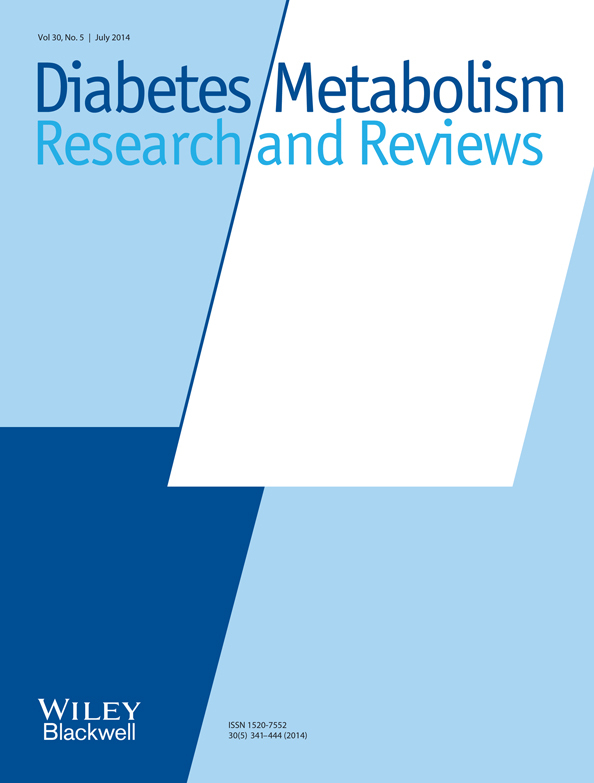Aiming for better glucose control: is HbA1c of 7% the ‘holy grail’? The clinical approach or seven clinical questions about 7
Shlomit Koren
Department of Internal Medicine A and Diabetes Unit, Assaf Harofe Medical Center, Sackler Faculty of Medicine, Tel Aviv University, Tel Aviv, Israel
Search for more papers by this authorCorresponding Author
Micha J. Rapoport
Department of Internal Medicine C, Assaf Harofe Medical Center, Sackler Faculty of Medicine, Tel Aviv University, Tel Aviv, Israel
Correspondence to: Micha J. Rapoport, Department of Internal Medicine C, Assaf Harofe Medical Center, Zerifin, 70300, Israel.
E-mail: [email protected]
Search for more papers by this authorShlomit Koren
Department of Internal Medicine A and Diabetes Unit, Assaf Harofe Medical Center, Sackler Faculty of Medicine, Tel Aviv University, Tel Aviv, Israel
Search for more papers by this authorCorresponding Author
Micha J. Rapoport
Department of Internal Medicine C, Assaf Harofe Medical Center, Sackler Faculty of Medicine, Tel Aviv University, Tel Aviv, Israel
Correspondence to: Micha J. Rapoport, Department of Internal Medicine C, Assaf Harofe Medical Center, Zerifin, 70300, Israel.
E-mail: [email protected]
Search for more papers by this authorSummary
The diabetes epidemic imposes a substantial burden on health systems and economy all over the world. Over the last two decades, many health systems adopted health care quality and performance measures for diabetes mellitus, most notably haemoglobin A1c. This article raises concerns regarding the significance of HbA1c as a performance measure and emphasizes the need for individualized therapy. Copyright © 2014 John Wiley & Sons, Ltd.
References
- 1The effect of intensive treatment of diabetes on the development and progression of long-term complications in insulin-dependent diabetes mellitus. The Diabetes Control and Complications Trial Research group. N Engl J Med 1993; 329(14): 977–986.
- 2Effect of intensive blood-glucose control with metformin on complications in overweight patients with type 2 diabetes (UKPDS 34). UK Prospective Diabetes Study (UKPDS) group. Lancet 1998; 352(9131): 854–865.
- 3Intensive blood-glucose control with sulphonylureas or insulin compared with conventional treatment and risk of complications in patients with type 2 diabetes (UKPDS 33). UK Prospective Diabetes Study (UKPDS) group. Lancet 1998; 352(9131): 837–853.
- 4 Ohkubo Y, Kishikawa H, Araki E, et al.. Intensive insulin therapy prevents the progression of diabetic microvascular complications in Japanese patients with non-insulin-dependent diabetes mellitus: a randomized prospective 6-year study. Diab Res Clin Pract 1995; 28(2): 103–117.
- 5 Holman RR, Paul SK, Bethel MA, Matthews DR, Neil HA. 10-year follow-up of intensive glucose control in type 2 diabetes. N Engl J Med 2008; 359(15): 1577–1589.
- 6 Nathan DM, Cleary PA, Backlund JY, et al.. Intensive diabetes treatment and cardiovascular disease in patients with type 1 diabetes. N Engl J Med 2005; 353(25): 2643–2653.
- 7Standards of medical care in diabetes--2013. Diabetes Care 2013; 36(Suppl 1): S11–S66.
- 8 Cheung NW, Conn JJ, d'Emden MC, et al.. Position statement of the Australian Diabetes Society: individualisation of glycated haemoglobin targets for adults with diabetes mellitus. Med J Aust 2009; 191(6): 339–344.
- 9 Handelsman Y, Mechanick JI, Blonde L, et al.. American Association of Clinical Endocrinologists medical guidelines for clinical practice for developing a diabetes mellitus comprehensive care plan. Endocr Pract 2011; 17(Suppl 2): 1–53.
- 10 Inzucchi SE, Bergenstal RM, Buse JB, et al.. Management of hyperglycemia in type 2 diabetes: a patient-centered approach: position statement of the American Diabetes Association (ADA) and the European Association for the Study of Diabetes (EASD). Diabetes Care 2012; 35(6): 1364–1379.
- 11 Bhattacharyya OK, Estey EA, Cheng AY. Update on the Canadian Diabetes Association 2008 clinical practice guidelines. Can Fam Physician 2009; 55(1): 39–43.
- 12
Home P,
Haddad J,
Latif ZA, et al.. Comparison of national/regional diabetes guidelines for the management of blood glucose control in non-Western Countries. Diab Ther 2013; 4(1): 91–102.
10.1007/s13300-013-0022-2 Google Scholar
- 13 Hanas R, John G. 2010 Consensus statement on the worldwide standardization of the hemoglobin A1c measurement. Diabet Med 2010; 27(7): 737–738.
- 14 Hinzmann R, Schlaeger C, Tran CT. What do we need beyond hemoglobin A1c to get the complete picture of glycemia in people with diabetes? Int J Med Sci 2012; 9(8): 665–681.
- 15The International Expert Committee. International Expert Committee report on the role of the A1C assay in the diagnosis of diabetes. Diabetes care 2009; 32(7): 1327–1334.
- 16 Pinelli NR, Jantz AS, Martin ET, Jaber LA. Sensitivity and specificity of glycated hemoglobin as a diagnostic test for diabetes and prediabetes in Arabs. J Clin Endocrinol Metab 2011; 96(10): E1680–E1683.
- 17 Herman WH. Do race and ethnicity impact hemoglobin A1c independent of glycemia? J Diabetes Sci Technol 2009; 3(4): 656–660.
- 18 Garg R, Williams ME. Diabetes management in the kidney patient. Med Clin North Am 2013; 97(1): 135–156.
- 19 Duckworth W, Abraira C, Moritz T, et al.. Glucose control and vascular complications in veterans with type 2 diabetes. N Engl J Med 2009; 360(2): 129–139.
- 20 Gerstein HC, Miller ME, Byington RP, et al.. Effects of intensive glucose lowering in type 2 diabetes. N Engl J Med 2008; 358(24): 2545–2559.
- 21 Patel A, MacMahon S, Chalmers J, et al.. Intensive blood glucose control and vascular outcomes in patients with type 2 diabetes. N Engl J Med 2008; 358(24): 2560–2572.
- 22 Haffner SM, Lehto S, Ronnemaa T, Pyorala K, Laakso M. Mortality from coronary heart disease in subjects with type 2 diabetes and in nondiabetic subjects with and without prior myocardial infarction. N Engl J Med 1998; 339(4): 229–234.
- 23 Buse JB, Ginsberg HN, Bakris GL, et al.. Primary prevention of cardiovascular diseases in people with diabetes mellitus: a scientific statement from the American Heart Association and the American Diabetes Association. Circulation 2007; 115(1): 114–126.




